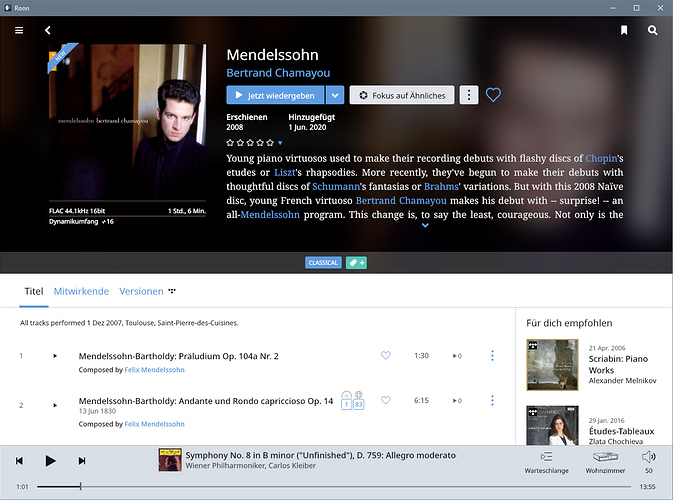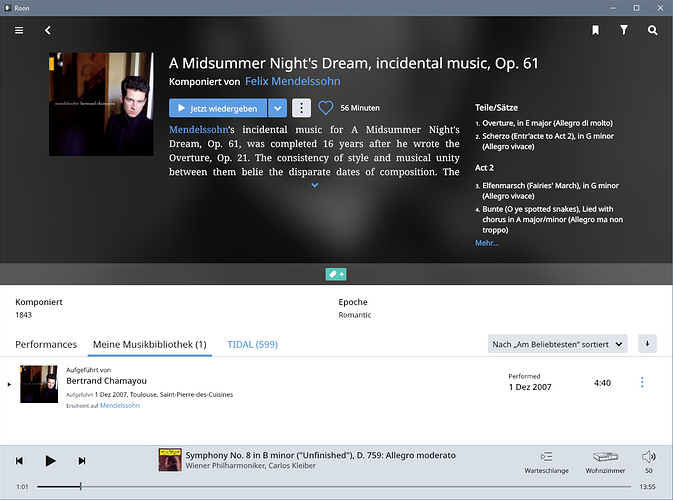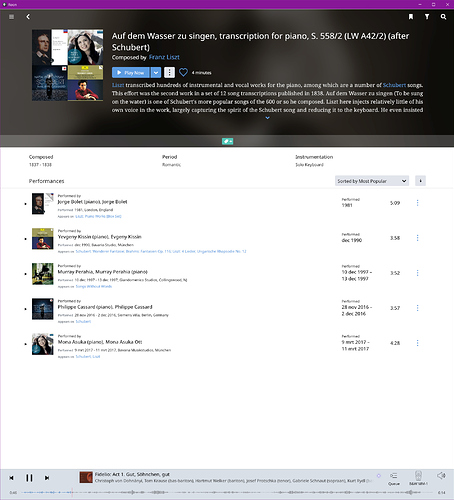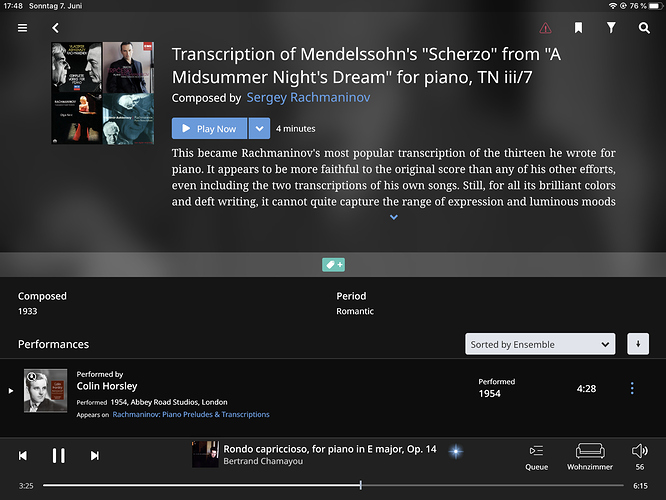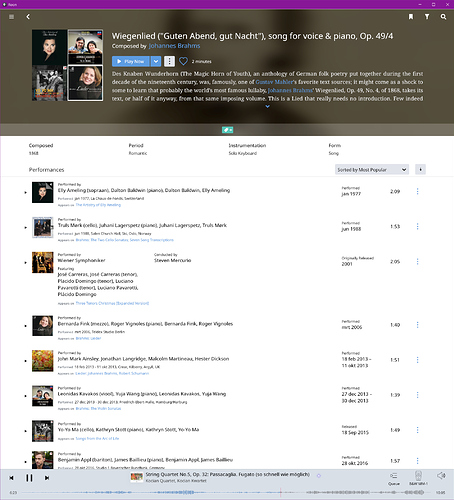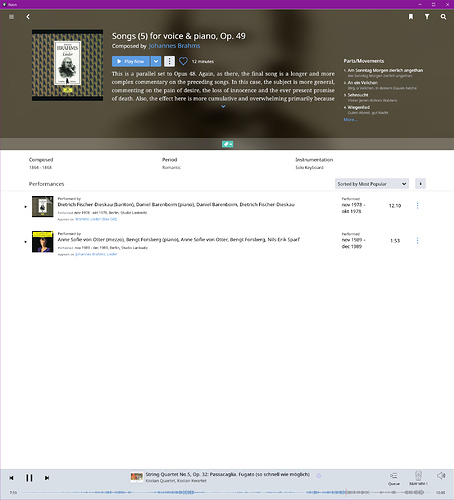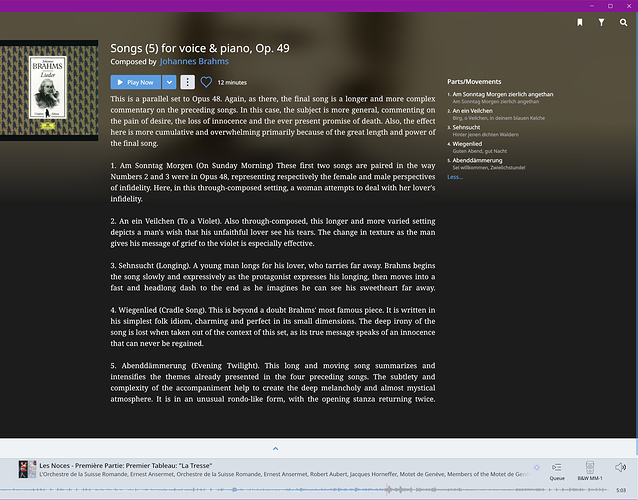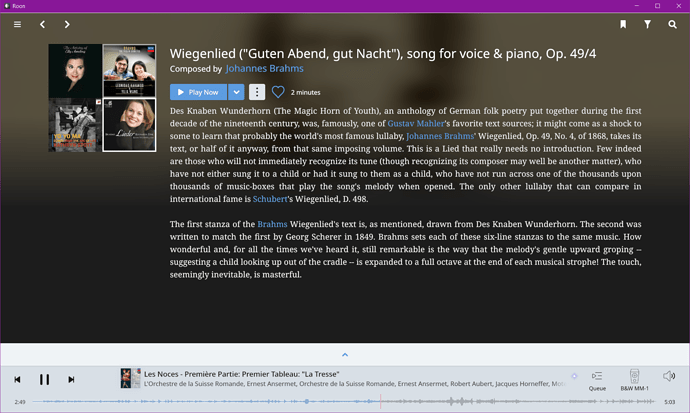Not sure if I’m barking up the correct tree here, but I thought this way I’d at least reach the right audience!
I’ve got a pressing matter that’s been gnawing at my nerves for quite a while now and it’s this:
Roon often has two instances of a song in its composition database:
- An individual song that is part of a collection or cycle that carries both an opus number as well as an order number
- The collection of songs or the cycle, carrying only an opus number
Here’s an example of the first case, the Brahms song Wiegenlied:
And here’s the complete Opus 49:
Now I’d like to make an informed choice when I adapt my own file tags. Up until now, I’ve always tagged songs such as Wiegenlied when it’s recorded on a cd without its brethren from the same main composition, in this case opus 49:
Title-tag: Op.49: 4 Wiegenlied ‘Guten Abend, gut’ Nacht’ (1ste strofe: Aus: ‘Des Knaben Wunderhorn’ / 2de strofe: Georg Scherer)
Album-tag: Brahms - Fünf Lieder, Op.49 (sel) (Renée Fleming, Hartmut Höll 24-48 2017)
Composition-tag: Fünf Lieder, Op.49 (sel)
Movement-tag: 4 Wiegenlied ‘Guten Abend, gut’ Nacht’ (1ste strofe: Aus: ‘Des Knaben Wunderhorn’ / 2de strofe: Georg Scherer)
Composer-tag: Johannes Brahms
Note: The Composition and Movement tags actually are the Custom1 and Custom2 tags that MediaMonkey does support where it fails to support the WORK or PART/MOVEMENT tags that Roon reads and uses. But that’s beside the point for the moment. I have found a way to make MediaMonkey write WORK/MOVEMENT tags programmatically using a script. And I’m very slowly working my way through my collection exchanging my previous Dutch language compositions for the canonical, English ones that Roon uses, simply because I want my library to be consistent within itself AND congruent with Roon.
By the way: the rather awkward way in which I filled Album tags was my original way to have the composition written out in full in the Album title while the movement could het its due within the Title tag. These two unfortunately are the only tags that Sonos showed (besides the Artist tag that Roon has now made entirely unusable for me) giving me composition-related information and I wanted to be able to use Sonos next to my Linn, for which I could use BubbleDS in conjunction with MinimServer. For those in the know this might begin to explain why I used to tag my files in such a strange way…
I am almost totally ‘converted’ to the Roon way of doing things which means, among many other things, that I’m now slowly replacing the many Album titles I used for one album, with just the one Album title which is the one on the cd cover. This helps having Roon recognize and identify more of my albums.
I still use my three Sonoses (in the bedroom, bathroom and kitchen) a lot but I really dislike its controller app. So in the end I will just use Roon to stream music from my library to the Sonos endpoints.
There are many many things wrong about Sonos’s software! To name just two more: there’s a limit to the number of tracks that it can hold in its database (ca. 64,000 but in practice much less when the tag values contain a lot of characters) and it doesn’t know about Composers, except when in search mode. And search mode only works when you keep your library under the 64k limit which I crossed quite early on forcing me to trick Sonos with the aid of .m3u playlists, one for every classical album (actual issues, not the type of album that only holds one composition…), so I could make Sonos count only these playlist files and not the actual number of tracks. A complex and difficult story that I won’t bore you with any further…
Right now I’m completely at a loss as to which composition I should use for a seperate song such as Wiegenlied.
The description of the complete Opus 49 Roon gives is:
while the description of the individual Wiegenlied look like this:
As one can see, the descriptions are quite different and sort of complement each other.
I think that I would prefer if Roon found a way to merge these two sources of information into one. But that’s probably not going to happen anytime soon…
What’s your perspective on this matter, @bbrip, @Tony_Casey, @Martin_F, @dylan and others?


